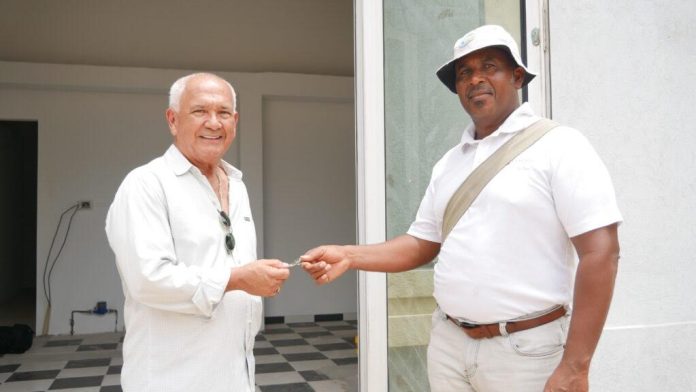On May 24th, Stichting Rancho announced via their social media platforms that they have signed an agreement to use the Nikki Habibe building in Oranjestad. The goal is to create a multifunctional and creative space where the public can learn more about the history of Oranjestad and celebrate the city’s 200th anniversary.
This building is located at Nikki Habibe Plaza. The foundation explained that this is a central location visited by both locals and tourists. Additionally, the area hosts various local businesses offering different types of services.
The aim is for Stichting Rancho to collaborate with these local businesses to create more activity in the city center. The foundation further explained that this space will temporarily serve as a reference point for those who want to learn about the history of Oranjestad. It will also function as a sales point for artistic works and products reflecting the theme of the 200th anniversary celebration of Oranjestad.
This initiative has been made possible with the support and backing of various stakeholders and aims to demonstrate how NGOs and the private sector can collaborate to create social and cultural initiatives in Oranjestad.
“Stichting Rancho is open to collaboration with local artists to showcase their works and make the space multifunctional. Oranjestad offers a central point for developing your creations and expressions. Feel free to contact us to explore the possibility of joining and working together. The community of Aruba is invited to learn more about Oranjestad and participate in the 200th-anniversary celebration,” the foundation emphasized.
Clifford Rosa, director of Stichting Rancho, explained that they are working to hold events on June 24th and July 24th to kick off the celebrations, with the main event scheduled for August 24, 2024.
“The first step currently is the Nikki Habibe initiative, and the first event is planned for June 24th,” he highlighted.
For some time now, Stichting Rancho has been promoting the celebration of Oranjestad’s 200th anniversary and what this means for Aruba. The foundation’s mission is to create a joyful union and involve everyone who knows Aruba in one way or another to contribute together and celebrate the bicentennial of Oranjestad in an epic and unique way this year.
“With the ultimate goal of taking advantage of this historical opportunity to celebrate together our history and heritage of our beloved Oranjestad and the entire Aruba,” Stichting Rancho underscored.
History
According to the foundation, the history of Oranjestad began with a population situated near Paardenbaai, which provided good access for larger ships, resulting in lively trade.
The fishermen, due to their proximity to Oranjestad’s administrative heart, found a market for their fish. Initially, the population consisted of modest huts made of maize stalks, firmly woven and later covered with clay.
According to Johan Hartog’s book published in 1996, “Aruba in oude ansichten,” Rancho was a small fishing village where around fifty fishermen lived. After 1935, when house numbering began, the boundaries became somewhat blurred, and it became part of Oranjestad.
In 1912, Rancho was first mentioned on a map by Johannes Werbata. At that time, the district was bounded by the salt flats, Paardenbaai, Socotoro, and Oranjestad. Older residents still mention the entrance gate, Port’i Eagle, a square located in Arendstraat, near Franklinstraat.
Regarding the southern boundary, the foundation indicates that there was no total agreement. Some believe the sea formed the boundary, while others think the current J.G. Emanstraat (formerly Noordstraat) was the boundary. The area where Havenstraat, Schelpstraat, and L.G. Smith Blvd. are located is still a subject of discussion. By the end of the 20th century, the neighborhood was populated, and Rancho officially became part of Oranjestad.
The 1912 Werbata map also marks a rancho at the mouth of San Nicolas (now known as Rodgers Beach), but this name is no longer mentioned. Rancho not only provided housing for the fishing community (in the early 1900s, there were about fifty), but also for the itinerant traders who tried to sell their goods to the island’s population during the day and found lodging and enjoyment.
The wharf provided (mostly at night) a good opportunity for the illegal importation of contraband goods, such as barrels of rum and other alcoholic beverages from Curaçao, which were floated ashore with buoys and brought to land by the Rancheros.

















